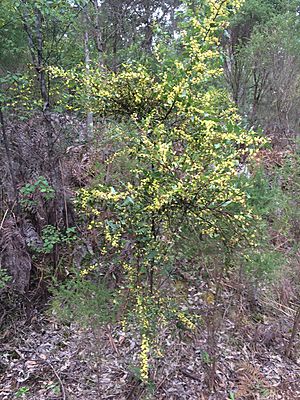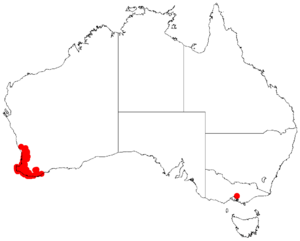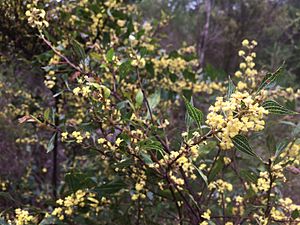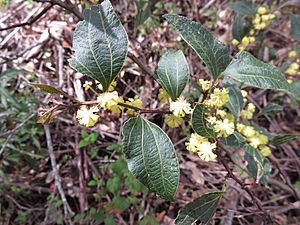Pointed leaved acacia facts for kids
Quick facts for kids Pointed leaved acacia |
|
|---|---|
 |
|
| A. urophylla habit | |
| Scientific classification | |
| Genus: |
Acacia
|
| Species: |
urophylla
|
 |
|
| Occurrence data from AVH | |

Acacia urophylla, also known as the pointed leaved acacia or net-leaved wattle, is a type of shrub. It belongs to the Acacia family and is found only in Western Australia.
Contents
What Does Acacia urophylla Look Like?
This plant is a tall, slender shrub. It usually grows to be about 1 to 3 meters (3 to 10 feet) tall. Its branches have clear yellow ribs. They also have sharp, hard stipules, which are small leaf-like parts, about 2 to 8 millimeters long.
The leaves of Acacia urophylla are thin and stay green all year. They are shaped like a spear or an egg. These leaves are usually 5 to 11 centimeters (2 to 4 inches) long. They are also 1 to 4 centimeters (0.4 to 1.6 inches) wide. Each leaf has two to four strong lines running along it.
Flowers and Seeds
This acacia blooms from May to October. It produces pretty cream-yellow flowers. The flowers grow in groups called inflorescences. These groups have two to five flower heads. Each flower head is round and has 8 to 12 pale yellow or white flowers.
After the flowers, black, slightly woody seed pods grow. They are twisted and thin, about 14 centimeters (5.5 inches) long. Each pod is 2 to 4 millimeters (0.08 to 0.16 inches) wide. Inside, there are shiny dark brown seeds. These seeds are about 3 to 4 millimeters (0.12 to 0.16 inches) long.
This shrub is also strong against a plant disease called dieback.
How Acacia urophylla Got Its Name
The plant was first officially described in 1841. This was done by a scientist named George Bentham. For a short time in 2003, it was called Racosperma urophyllum. But in 2006, it was moved back to the Acacia group.
The name urophylla comes from Greek words. Uro- means 'long part' and phylla means 'leaves'. This name describes the shape of the plant's leaves. Acacia urophylla is part of the Acacia myrtifolia group. It is very similar to another plant called Acacia scalpelliformis.
Where Does Acacia urophylla Grow?
This plant grows naturally in Western Australia. You can find it from south of New Norcia down to Augusta. It also grows east towards Walpole.
It likes to grow near water in damp places. It prefers lateritic soils. In the southwest, it often grows under tall Eucalyptus diversicolor trees. After bushfires, it can grow very thickly. In northern areas, it is less common. There, it grows in small groups along creeks. These creeks are often in Eucalyptus marginata forests.
Growing Acacia urophylla
You can buy the seeds of this plant. Before planting, the seeds need special care. You can soak them in boiling water. Or you can gently scratch their surface. This helps them sprout. People also use this plant to help fix damaged land in its native areas.


